- Home
- Hermann Hesse
The Glass Bead Game
The Glass Bead Game Read online
The author and publisher have provided this e-book to you for your personal use only. You may not make this e-book publicly available in any way. Copyright infringement is against the law. If you believe the copy of this e-book you are reading infringes on the author's copyright, please notify the publisher at: us.macmillanusa.com/piracy.
CONTENTS
Title Page
Copyright Notice
Dedication
Foreword by Theodore Ziolkowski
The Glass Bead Game: A General Introduction to Its History for the Layman
The Life of Magister Ludi Joseph Knecht
1. The Call
2. Waldzell
3. Years of Freedom
4. Two Orders
5. The Mission
6. Magister Ludi
7. In Office
8. The Two Poles
9. A Conversation
10. Preparations
11. The Circular Letter
12. The Legend
Joseph Knecht's Posthumous Writings
The Poems of Knecht's Student Years
The Three Lives
1. The Rainmaker
2. The Father Confessor
3. The Indian Life
Copyright
dedicated to the Journeyers to the East
Foreword by Theodore Ziolkowski The Glass Bead Game, Hermann Hesse's last major work, appeared in Switzerland in 1943. When Thomas Mann, then living in California, received the two volumes of that first edition, he was dumbfounded by the conspicuous parallels between Hesse's "Tentative Sketch of the Life of Magister Ludi Joseph Knecht" and the novel that he himself was writing, Doctor Faustus (1947). For all their differences in mood, style, and theme, both works employ a similar fiction: a pleasant though somewhat pompous narrator recounts, with a sympathy matched only by his pedantry, the life of a man whom he loves and admires. Since in each case the narrator is incapable of fully comprehending the problematic genius of his biographical subject, an ironic tension is produced between the limited perspective of the narrator and the fuller vision that he unwittingly conveys to the reader. Both authors were obsessed, in addition, with what they regarded as the self-destructive course of modern civilization, and this concern pervades both novels. But Mann's view is more immediate. His narrator, Serenus Zeitblom, can see and hear the exploding bombs of World War II as he writes, and the spectacular career of the composer Adrian Leverkuhn parallels with ominous precision the history of Germany from the declining Empire through the shortlived brilliance of the Weimar Republic to the raging madness of National Socialism. In Hesse's novel, in contrast, that same period is described with the detachment of a narrator looking back at the "Age of the Feuilleton" from a vantage point in the distant future. Unlike Mann's Leverkuhn, Hesse's Joseph Knecht succeeds in analyzing the dangers of an excessive aestheticism and acts to avert the catastrophe of intellectual irresponsibility. In both novels, finally, the authors slyly weave their experience of our culture into a pastiche of hidden quotations and characters a clef.
Thomas Mann, immediately sensing that the serious theme of Hesse's novel was enclosed within "a cunning artistic joke," recognized the source of its humor in "the parody of biography and the grave scholarly attitude." But people won't dare to laugh, he wrote Hesse. "And you will be secretly annoyed at their dead-earnest respect." Hesse was pleased that his friend had put a finger on the comic aspect of the novel, but Mann's prediction was correct. In the nearly half a century since its publication, The Glass Bead Game has enjoyed the adulation customarily awarded to literary "classics." Indeed, largely on its merits Hesse received in 1946 the Nobel Prize for which Mann, among others, had repeatedly nominated him. Hesse's opus magnum was one of the first works by a distinguished emigre to be published in Germany after the war, and it has been regularly reprinted there since 1946. The book was dutifully translated into English, Swedish, French, Spanish, Italian, and other languages. But the novel, whose title supplied us with one of those imagistically suggestive catchwords for our age, like "the Waste Land" or "the Magic Mountain," has suffered the fate of many classics--it is less frequently read than cited, more often studied than appreciated. In Germany many readers, blandly ignoring the implicit criticism in the novel, tended to see in Hesse's cultural province nothing but a welcome utopian escape from harsh postwar realities. More discerning European critics have usually been so preoccupied with the fashionably grave implications that they have neither laughed at its humor nor smiled at its ironies.
In part these one-sided readings are understandable, for the humor is often hidden in private jokes of the sort to which Hesse became increasingly partial in his later years. The games begin with the motto attributed to "Albertus Secundus," which is actually fictitious. Hesse wrote the motto himself and had it translated into Latin by two former schoolmates, who are cited in Latin abbreviation as the editors: Franz Schall ("noise" or Clangor) and Feinhals ("slender neck" or Collo fino). The book is full of this "onomastic comedy" that appealed to Thomas Mann, also a master of the art. Thus Carlo Ferromonte is an italianized form of the name of the author's nephew, Karl Isenberg, who assisted Hesse with the music history that is interwoven with the history of the Glass Bead Game. The "inventor" of the Game, Bastian Perrot of Calw, gets his name from Heinrich Perrot, the owner of a machine shop where Hesse once worked for a year after he dropped out of school. The figure of Thomas von der Trave is a detailed and easily recognizable portrait of Thomas Mann, who was born in the town of Lubeck on the river Trave. In the person of Fritz Tegularius, Hesse has given us his interpretation of the brilliant but unbalanced character of Friedrich Nietzsche. And Tegularius' spiritual opponent in the novel, Father Jacobus, borrows some of his words and most of his ideas from Nietzsche's antagonist, the historian Jakob Burckhardt. The reader who fails to catch these sometimes obscure references is not only missing much of the fun of the book, he is also unaware of its implications in the realm of cultural history and criticism.
The reception of The Glass Bead Game in this country has been affected by other factors as well. The book was available after 1949 under the misleading title Magister Ludi. But if it failed to make an impact, this was due equally to the translation by Mervyn Savill, which fails to bring out its irony, and to the fluctuations of Hesse's reputation in the United States. Although Hesse's stature was recognized in Europe (where he was praised by such admirers as Thomas Mann, Andre Gide, and T. S. Eliot) for some thirty years before he received the Nobel Prize, Time magazine noted in 1949 that his works were still virtually unknown here. His eightieth birthday, widely celebrated abroad, passed unnoticed in the United States in 1957. And when Hesse died in 1962, a New York Times obituary stated that he was "largely unapproachable" for American readers. This neglect was due in part to the introspective, lyrical quality of his novels, which depart radically from the more realistic tradition that dominated American fiction between the world wars. But another circumstance was probably more important in accounting for the lack of interest in his works for a good fifteen years after he received the Nobel Prize. Hesse's novels fictionalize the admonitions of an outsider urging us to question accepted values, to rebel against the system, to challenge conventional "reality" in the light of higher ideals. For almost two decades after World War II our society was characterized largely by the button-down-collar mentality of a silent generation whose goal it was to become a part of the establishment and to reap its benefits as rapidly as possible. Such ages have little use for critics of the system and prophets of the ideal.
But the times changed, and Hesse suddenly became relevant for a generation bent on the rejection of the consumer society of the pre-Kennedy era. But relevance resides in the mind of the perceiver, and the under-thirty gener
ation that embraced Hesse in the sixties--first as an underground classic and later as a text in high school and college courses--was better known for its rebelliousness than for its sense of irony. As a result, the Hesse cult in the United States revolved primarily around such painfully humorless works as Demian and Siddhartha, in which readers discovered an anticipation of their infatuation with Eastern mysticism, pacifism, the search for personal values, and revolt against the establishment. Those who moved on to Steppenwolf greeted it as a psychedelic orgy of sex, drugs, and jazz, but conveniently overlooked the ironic attitude through which those superficial effects are put back into perspective by the author. It was partly as a reaction against such self-indulgent interpretations, which he encountered as early as the twenties, that Hesse undertook The Glass Bead Game.
What is the "Glass Bead Game"? In the idyllic poem "Hours in the Garden" (1936), which he wrote during the composition of his novel, Hesse speaks of "a game of thoughts called the Glass Bead Game" that he practiced while burning leaves in his garden. As the ashes filter down through the grate, he says, "I hear music and see men of the past and future. I see wise men and poets and scholars and artists harmoniously building the hundred-gated cathedral of Mind." These lines depict as personal experience that intellectual pastime that Hesse, in his novel, was to define as "the unio mystica of all separate members of the Universitas Litterarum" and that he bodied out symbolically in the form of an elaborate Game performed according to the strictest rules and with supreme virtuosity by the mandarins of his spiritual province. This is really all that we need to know. The Glass Bead Game is an act of mental synthesis through which the spiritual values of all ages are perceived as simultaneously present and vitally alive. It was with full artistic consciousness that Hesse described the Game in such a way as to make it seem vividly real within the novel and yet to defy any specific imitation in reality. The humorless readers who complained to Hesse that they had invented the Game before he put it into his novel--Hesse actually received letters asserting this!--completely missed the point. For the Game is of course purely a symbol of the human imagination and emphatically not a patentable "Monopoly" of the mind.
The Game, in turn, is the focal point and raison d'etre of an entire province of the spirit called Castalia (from the Parnassian spring sacred to the Muses) and located in an unspecified future. (Hesse has indicated that he thought of his narrator as writing around the beginning of the twenty-fifth century.) But again Hesse makes it clear that he is not predicting a specific utopia but, rather, trying to represent the model of a reality that has actually existed from time to time in such orders as the Platonic academies or yoga schools. It is "a spiritual culture worth living in and serving," he explained to one correspondent. Castalia, in other words, represents any human institution devoted wholly and exclusively to affairs of the mind and imagination. As such, the spiritual province of the novel constitutes the goal of a search upon which Hesse had been embarked for many years. But this last novel is at the same time the document of an intense personal crisis, for it depicts not only the fulfillment of a long sought ideal, but also its ultimate rejection.
Hesse's literary career parallels the development of modern literature from a fin de siecle aestheticism through expressionism to a contemporary sense of human commitment. Born in the Black Forest town of Calw in 1877, Hesse in his youth reflected the neo-romanticism then prevalent among many writers of his generation in England, France, and Germany. The misty yearnings of his earliest stories and poems display the frank escapism of a young man, not at home in the bourgeois reality of Wilhelmine Germany, who projects his dreams into a romantic kingdom that he locates, according to the title of one work, "An Hour beyond Midnight." But the success of his first major novel, Peter Camenzind (1904), reconciled the young writer, at least temporarily, with a world that was prepared to bestow upon him the material rewards of literary fame. From aestheticism he shifted to the melancholy realism that marked his next poems and stories as well as the novels Under the Wheel (1906), Gertrude (1910), and Rosshalde (1914). Putting aside his romantic longings, he assumed the role of a settled family man who advocated in his fictions a bittersweet doctrine of renunciation and compromise.
But the war brought a radical change. Hesse, who had been living in Switzerland since 1912, found that his outspoken pacifism alienated many of his former friends and readers, who succumbed to the wave of martial exhilaration sweeping over Europe in August of 1914. Meanwhile, family and marital difficulties shattered the illusion of a happy life that he had carefully sought to preserve for some ten years. A lengthy psychoanalytic treatment at the hands of a disciple of Jung in 1916 and 1917 completed his disillusionment with his present state and the process of psychic re-evaluation. Hesse came to the conclusion that he had been living a lie and denying the authentic impulses of his own being. In 1919 he moved to the village of Montagnola, near Lugano in southern Switzerland, where he lived in relative seclusion until his death in 1962. Here he wrote most of the major works for which he subsequently became famous and in which he sought to discover a more mature ideal of the spirit to replace that "reality" with which he had become disenchanted.
In several essays that he wrote around 1920--most notably in pieces on Nietzsche and Dostoevsky--Hesse argued that men must seek a new morality that, transcending the conventional dichotomy of good and evil, will embrace all extremes of life in one unified vision. A later essay, "A Bit of Theology" (1932), outlines the three-stage progression toward this goal. The child, he says, is born into a state of unity with all being. It is only when the child is taught about good and evil that he advances to a second level of individuation characterized by despair and alienation; for he has been made aware of laws and moral codes, but feels incapable of adhering to the arbitrary standards established by conventional religious or moral systems since they exclude so much of what seems perfectly natural. A few men--like the hero of Siddhartha or those whom Hesse calls "the Immortals" in Steppenwolf--manage to attain a third level of awareness where they are once again capable of accepting all being. But most men are condemned to live on the second level, sustained only by a sense of humor through which they neutralize oppressive reality and by an act of the imagination through which they share from time to time in the kingdom of the Immortals, the realm of spirit.
Hesse's novels trace this struggle in the lives of heroes set against backgrounds from different ages of civilization. In each case the triadic rhythm of development is the same; only the historical circumstances differ. In Demian (1919) the milieu is that of the student generation of the turbulent years immediately preceding World War I. The hero of Siddhartha (1922) progresses through the three stages in the classical India of Buddha. Steppenwolf (1927) ironically depicts the dilemma of a European intellectual confronted with the tawdry pop culture of the twenties, while the dual protagonists of Narcissus and Goldmund (1930) act out their individuation in the waning of the Middle Ages. In the thinly veiled symbolic autobiography of The Journey to the East (1932), finally, the hero joins a League of Journeyers to the East in a timeless present set sometime after "the Great War." Each novel postulates the possibility of a spiritual kingdom toward which the hero strives, whether he reaches it or not.
Castalia is clearly another attempt, this time projected into the future, to represent this same ideal: a symbolic realm where all spiritual values are kept alive and present, specifically through the practice of the Glass Bead Game. In this sense, then, the novel was originally envisaged as yet another variation in Hesse's continuing search for a spiritual dimension of life, for it depicts a future society in which the realm of Culture is set apart to pursue its goals in splendid isolation, unsullied by the "reality" that Hesse had grown to distrust.
The Glass Bead Game was a continuation and intensification in another sense as well. Hesse was aware of the fact that his earlier novels had employed the same basic pattern of individual development against different historical backgrounds. He now decided to inco
rporate this structural tendency into a single new novel. The idea that came to him, he wrote to a friend in 1945, was "reincarnation as a mode of expression for stability in the midst of flux." Long before he began writing, he remarked, he had in mind "an individual but supratemporal life ... a man who experiences in a series of rebirths the grand epochs in the history of mankind." The novel, in other words, was to consist of a number of parallel lives, ranging through time, presumably, from the prehistoric past to the remote future. But the emphasis was to be distributed evenly among the parts. "The book is going to contain several biographies of the same man, who lives on earth at different times--or at least thinks that he had such existences," he wrote to his sister in 1934. Around this time Hesse wrote and published separately three such biographies: one about a prehistoric rainmaker; one set in the Golden Age of India; and a third depicting an episode from the patristic period of the early Christian church. (A fourth life, set among the Pietists of eighteenth-century Swabia, occupied Hesse for almost a year, but was never published during his lifetime.) As we now read the novel in its final form, of course, the arrangement of the parts is different. The biography of Joseph Knecht, which was to have been but the last in a long series of parallel lives, has grown to comprise the twelve central chapters of the book. The history of the Glass Bead Game and the organization of the cultural province are sketched in a lengthy introduction, and the three parallel lives, along with some poems, are added in an appendix as school exercises of young Knecht. Why this shift in plan, which seems to have taken place in the mid-thirties after parts of the book had already been written and published? At first it was simply a matter of expediency. Hesse found that he could best render "the inner reality of Castalia" through the figure of a dominating central figure. "And so Knecht stepped into the center of the narrative." In fact, in the first three chapters of his biography we get a far clearer idea of the Castalian ideal at its finest than in the narrator's more abstract introduction.

 Beneath the Wheel
Beneath the Wheel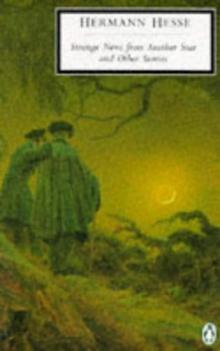 Strange News From Another Star
Strange News From Another Star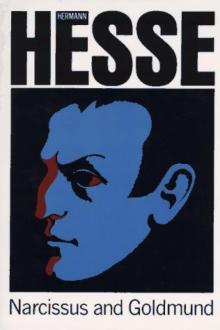 Narcissus and Goldmund
Narcissus and Goldmund Steppenwolf
Steppenwolf Siddhartha
Siddhartha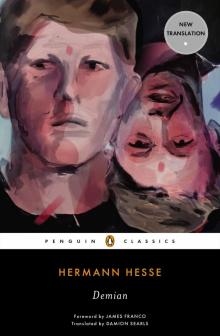 Demian
Demian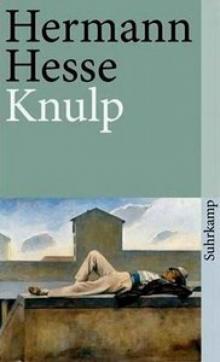 Knulp
Knulp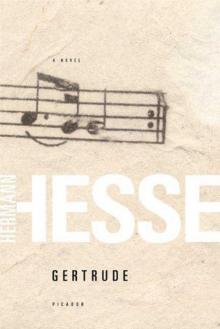 Gertrude
Gertrude Rosshalde
Rosshalde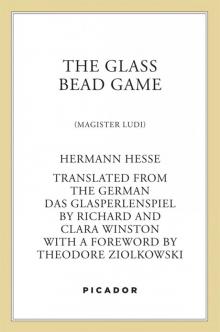 The Glass Bead Game
The Glass Bead Game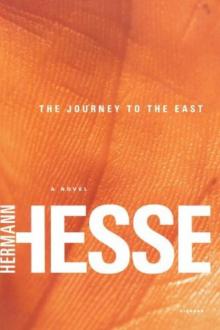 The Journey to the East
The Journey to the East Klingsor's Last Summer
Klingsor's Last Summer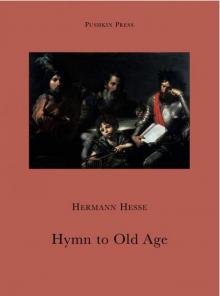 Hymn to Old Age
Hymn to Old Age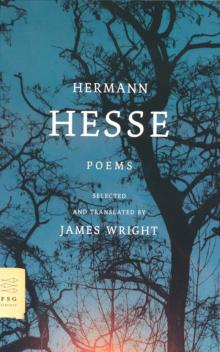 Poems
Poems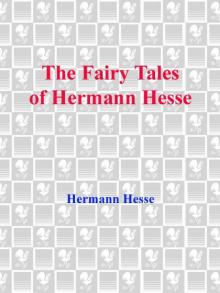 The Fairy Tales of Hermann Hesse
The Fairy Tales of Hermann Hesse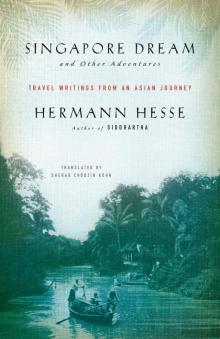 Singapore Dream and Other Adventures
Singapore Dream and Other Adventures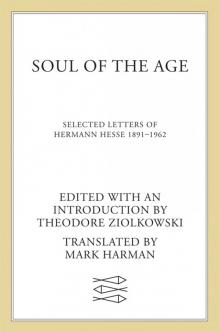 Soul of the Age
Soul of the Age